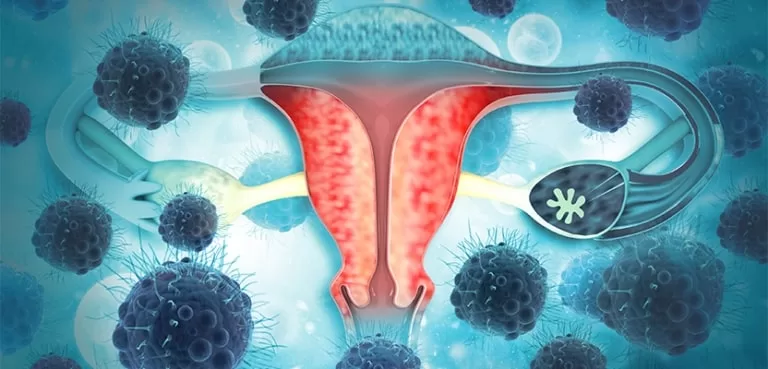+90 533 813 89 77
info@bookingforhealth.com
Ovarian Cancer
Ovarian cancer is a type of cancer that originates in the ovaries. The ovaries are a pair of small organs located on either side of the uterus that produce eggs and the hormones estrogen and progesterone.
Ovarian function can decline as women age, leading to menopause. Additionally, the ovaries can develop tumors, benign or malignant, which can affect the reproductive health and overall well-being of a woman.
Ovarian cancer is the fifth leading cause of cancer death among women and is more common in women over the age of 50.
There are several types of ovarian cancer, which are classified based on the type of cell they originate from. Each of them has different characteristics and may respond differently to treatment.

- Epithelial ovarian cancer
- Germ cell ovarian cancer
- Stromal ovarian cancer
Ovarian cancer, like every other type of cancer, generally consists of 4 stages. These have periods such as “a, b, c”.
Ovarian Cancer: Symptoms and Causes
Ovarian cancer is a type of illness that affects the ovaries, which are small organs located in the female reproductive system. The symptoms of ovarian cancer can be difficult to detect, as they are often subtle and may be mistaken for other conditions. Some common indicators include abdominal pain or discomfort, bloating, feeling full quickly while eating, and changes in bowel movements or urinary habits. Other ones may include fatigue, weight loss or gain, and back pain.
The exact causes of this cancer are not well understood, but certain factors are believed to increase a woman’s risk of developing the disease. These include increasing age, having a family history of ovarian or breast cancer, having a genetic predisposition to ovarian cancer, and having certain inherited genetic mutations, such as BRCA1 or BRCA2.
Other risk factors include having endometriosis, which is a condition in which the tissue that lines the uterus grows outside of it, and having been treated with infertility drugs.
It’s important to note that many women with these risk factors may not develop ovarian cancer, and many women who do develop the disease may not have any known risk factors.
If the patients have any symptoms that may be related to ovarian cancer, it is important to see a doctor for a proper evaluation. Early detection and treatment can improve the chances of survival for women with this cancer.
How is Ovarian Cancer Diagnosed?
Ovarian cancer can be challenging to diagnose because its symptoms are often subtle and may be mistaken for other conditions. There is no single test that can confirm or rule out this illness.
Diagnosis begins with a pelvic exam, during which the doctor feels the ovaries and uterus for any abnormalities. A pelvic ultrasound, which uses sound waves to create images of the related organs, may also be performed to help determine if there are any abnormal masses or growths present.
If there is any suspicion of ovarian cancer, the specialist likely order blood tests to check for an elevated level of a protein called CA-125. It is found in the blood of many women with this cancer, but it is not specific to ovarian cancer, and an elevated level of CA-125 can be caused by other conditions such as endometriosis, pelvic inflammatory disease, and even pregnancy.

Ovarian Cancer: Treatment
Treatment for ovarian cancer typically involves a combination of surgery and chemotherapy. The type of treatment and the order in which it is given depends on the stage and grade of the cancer, as well as the woman’s general states of health.
Surgery is typically the first line of treatment for ovarian cancer. The goal of surgery is to remove as much of the cancer as possible. Depending on the stage and grade of the cancer, the surgery may involve removing one or both ovaries, the fallopian tubes, the uterus, and any other nearby tissue that may contain cancer cells. In some cases, a hysterectomy may be performed to remove the uterus.
Chemotherapy is usually given after surgery to destroy any remaining cancer cells and reduce the risk of the cancer returning, like almost all cancer types. Chemotherapy may be given intravenously, or by mouth.
Radiation therapy is not commonly used to treat ovarian cancer, but in some cases it might be used as a complementary treatment to chemotherapy or surgery.
In addition to the traditional treatments, clinical trials may be available for some women with ovarian cancer, which can allow them to receive the latest treatments and access new drugs that are not yet widely available.
It’s necessary to evaluate that all treatment options with the specialists to understand the benefits, risks, and potential side effects of each treatment, and make an informed decision on which treatment is best for the patient.